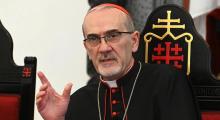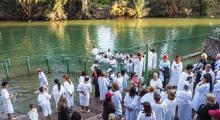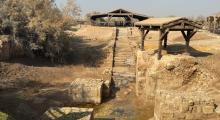Issued by the Catholic Center for Studies and Media - Jordan. Editor-in-chief Fr. Rif'at Bader - موقع أبونا abouna.org

At the invitation of the Petra Development Tourism Region Authority (PDTRA), for the first time in the modern era, Apostolic Nuncio to the Hashemite Kingdom of Jordan Bishop Giovanni Pietro Dal Toso celebrated Holy Mass at the Byzantine Church in Petra on Saturday, January 6, 2024.
PDTRA Chairman Fares Braizat said this prayer, held at the Byzantine Church in Petra, marks the start of adding Petra to the list of Christian pilgrimage sites in Jordan alongside the five existing and recognized sites, namely Mount Nebo, Makkawar in Madaba, the Baptism Site of Lord Jesus Christ, the Grotto of the Lady of the Mount, and in Tell Mar Elias in Ajloun.
In a statement to the Jordanian newspaper Ad-Dustour, Braizat added that the PDTRA seeks to have the prevailing ten churches in Petra to be eligible as part of the Christian pilgrimage route in Jordan, as well as to be associated with the existing church of Aqaba in order to create a new tourism view, as well as to prolong the tourists' stay in Petra and to attract more Christian pilgrims to the Kingdom in general and Petra in particular.
Mr. Braizat noted that this is the new tourism consideration which the PDTRA is planning to bring to light shortly. He added, "We also hope to enhance the dissemination of Amman Message of common living and tolerance through such functionaries, and to highlight the appropriate model of the Kingdom to visitors to the region from various countries of the world.
In his address, during the Holy Mass marking the Solemnity of the Epiphany of the Lord, Apostolic Nuncio to Jordan Bishop Giovanni Pietro Dal Toso thanked the Lord for being in a place that observes how manifold is the history of Jordan, and remarkable are the different cultures which can be met in Petra, namely the Nabatean civilization, the Christian message, and the Byzantine culture.
Stressing that all this makes from Petra a unique place in the world as the celebration of the Feast of Epiphany is rooted in ancient history, he refers to the three wise men coming from the Orient, the so called Magi, stating " these three wise men saw a star in heaven and the star led them to Jesus. For us as Christians the feast signifies that Christ came for the sake of everyone on Earth, and that the Gospel of Jesus is not confined to a certain culture or geographical area. Everyone can find in the Lord and in His message the truth one is looking for. Another important message is for us, that the Magi crossed the whole area of the Middle East, opening like a way of communication and of sharing among people of different cultures."
Noting that the celebration takes place in Petra because the magi, "brought as gift to Jesus gold, incense and myrrh, which were products the Nabateans here in Petra were used to trade, being on the road from the Arabic peninsula to Palestine and one's life, something what can inspire us, lead us, give us an orientation.
He went on to say that as the three wise, the Magi, were wise because their star was the wisdom, we need this wisdom especially in leadership, in politics, in culture, in economics, and in religion. He underlined that "those who are serving the people because of their responsibility in the different areas need the wisdom to guide their people in the right way: pursuing peace, justice, freedom and not hate, war, personal interests, making from the Middle East a place where people can live together.”
Apostolic Nuncio Bishop Giovanni Dal Toso recounted an event in the history of the Old Testament stating that Salomon was made king at a very young age, and knowing that he had to rule his people being young and having no experience, so he prayed seeking the Lord's wisdom.
Stating that our star should be the wisdom that the Lord wants to share with us, he said. "We want to pray today for this wisdom for all those who have responsibility not just in our Kingdom, but in the whole Middle East. This divine wisdom can help to resolve conflicts in a way that not generate new conflicts, but open the way to mutual understanding, reconciliation and peace."
He indicated that without the wisdom coming from the Lord it will be very difficult to understand the right road for our future, for the future of our country, for the future of our suffering region, and said that "as Christians we know that Jesus is the wisdom and He was born in order to share it with us."
He concluded his homily by asking the Lord that Jordan might continue to be a place of stability and freedom, opening a way of peace for the whole Middle East.
It is worthy to note that the Byzantine Church at Petra is a prime example of monumental architecture in Byzantine Petra. It sits on elevated ground in the city center, north of the so-called Colonnaded Street.
The Byzantine Church is notable for its lavish and well-preserved mosaic decoration. It is the find spot of 140 papyri that have provided scholars with valuable information about life in both Byzantine Petra and in its rural surroundings. These are referred to by scholars as the Petra papyri.
The church was excavated by the American Center of Oriental Research (ACOR) between 1992 and 2002. Archaeologists have concluded that the Church was originally built in the second half of the 5th century. It continued to be used as a religious structure until about the early seventh century CE, when it was destroyed by fire.







